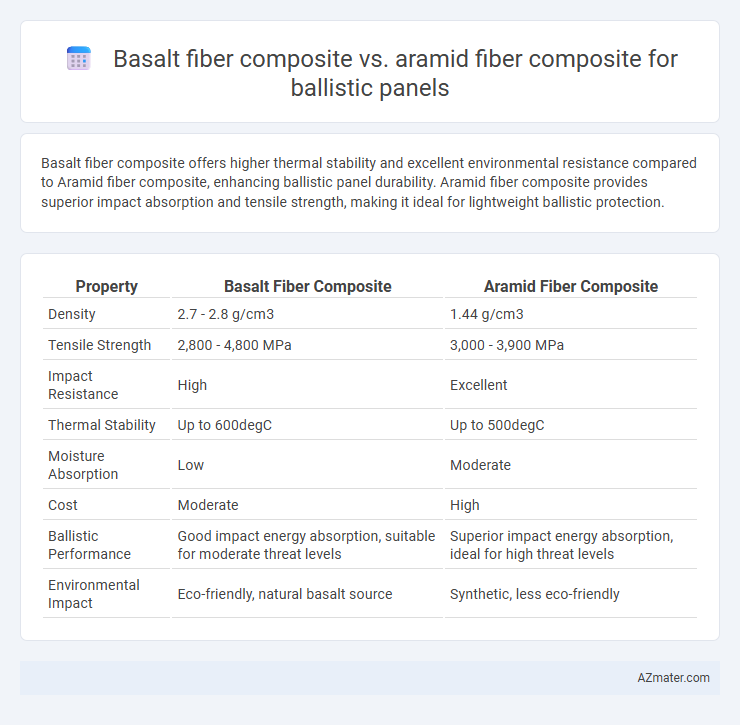Basalt fiber composite offers higher thermal stability and excellent environmental resistance compared to Aramid fiber composite, enhancing ballistic panel durability. Aramid fiber composite provides superior impact absorption and tensile strength, making it ideal for lightweight ballistic protection.
Table of Comparison
| Property | Basalt Fiber Composite | Aramid Fiber Composite |
|---|---|---|
| Density | 2.7 - 2.8 g/cm3 | 1.44 g/cm3 |
| Tensile Strength | 2,800 - 4,800 MPa | 3,000 - 3,900 MPa |
| Impact Resistance | High | Excellent |
| Thermal Stability | Up to 600degC | Up to 500degC |
| Moisture Absorption | Low | Moderate |
| Cost | Moderate | High |
| Ballistic Performance | Good impact energy absorption, suitable for moderate threat levels | Superior impact energy absorption, ideal for high threat levels |
| Environmental Impact | Eco-friendly, natural basalt source | Synthetic, less eco-friendly |
Introduction to Ballistic Panels
Ballistic panels utilize high-performance materials such as basalt fiber composites and aramid fiber composites to provide enhanced impact resistance and energy absorption. Basalt fiber composites are known for their superior thermal stability, corrosion resistance, and cost-effectiveness, making them suitable for long-lasting ballistic protection. Aramid fiber composites, including Kevlar, offer exceptional tensile strength, lightweight properties, and proven efficacy in stopping projectiles, establishing them as a standard in ballistic armor applications.
Overview of Basalt Fiber Composites
Basalt fiber composites, derived from volcanic basalt rock, offer high tensile strength, excellent thermal resistance, and superior environmental durability compared to traditional composites. These materials demonstrate enhanced ballistic performance due to their energy absorption capabilities and resistance to impact damage, making them a promising alternative in protective armor applications. Their eco-friendly production process and cost-effectiveness add significant advantages over aramid fiber composites in ballistic panel manufacturing.
Overview of Aramid Fiber Composites
Aramid fiber composites are renowned for their exceptional tensile strength, high energy absorption, and lightweight properties, making them a preferred choice in ballistic panels. These composites exhibit excellent resistance to impact and abrasion, providing superior protection against high-velocity projectiles. Their molecular structure allows efficient load distribution and thermal stability, enhancing durability and performance in personal armor and ballistic applications.
Key Mechanical Properties Comparison
Basalt fiber composites exhibit higher tensile strength and superior abrasion resistance compared to aramid fiber composites, making them more durable under ballistic impacts. Aramid fiber composites, such as Kevlar, offer exceptional energy absorption and impact resistance, crucial for stopping high-velocity projectiles. Both materials provide lightweight solutions, but basalt fiber composites typically have better thermal stability and chemical resistance, enhancing performance in extreme environments.
Ballistic Performance Analysis
Basalt fiber composites exhibit superior ballistic performance compared to aramid fiber composites due to their higher tensile strength, enhanced energy absorption capacity, and improved resistance to high-velocity impacts. The dense mineral structure of basalt fibers contributes to reduced back-face deformation and better multi-hit capability, making them highly effective in ballistic panels for protective applications. Ballistic performance analysis confirms basalt fiber composites provide enhanced durability and damage resistance under high strain rates typical of ballistic threats.
Durability and Environmental Resistance
Basalt fiber composites exhibit superior durability compared to aramid fiber composites, showcasing enhanced resistance to abrasion, impact, and fatigue under prolonged ballistic stress. Their inherent environmental resistance includes exceptional tolerance to UV radiation, moisture, and chemical exposure, which maintains structural integrity in harsh conditions. Aramid fiber composites, while strong and lightweight, are more susceptible to degradation from moisture and UV exposure, reducing their long-term performance in durable ballistic panels.
Weight and Thickness Considerations
Basalt fiber composites exhibit a lower density of approximately 2.6-2.8 g/cm3 compared to aramid fiber composites, which typically range from 1.4-1.5 g/cm3, influencing the overall weight of ballistic panels. Despite basalt's higher density, its superior compressive strength allows for potentially thinner panel designs without compromising ballistic protection levels. In contrast, aramid composites, known for high tensile strength and flexibility, often require thicker layers to achieve equivalent impact resistance, affecting the panel thickness and weight trade-off in ballistic applications.
Cost-Efficiency Evaluation
Basalt fiber composite offers a cost-efficient alternative to aramid fiber composite for ballistic panels due to its lower raw material and manufacturing expenses while maintaining comparable impact resistance and durability. The production cost of basalt fibers is significantly reduced as they are derived from abundant volcanic rock, which contributes to overall lower panel prices without sacrificing protective performance. Aramid fiber composites, although providing high tensile strength and established ballistic effectiveness, often incur higher costs related to complex fabrication and raw material scarcity, making basalt-based solutions more economically viable for large-scale deployment.
Manufacturing and Processing Differences
Basalt fiber composites offer simpler manufacturing processes due to their ability to be produced from natural volcanic rock with less chemical treatment compared to aramid fibers, which require complex polymer synthesis. Basalt fibers exhibit better thermal resistance and compatibility with a wider range of resin systems, enhancing their processing flexibility for ballistic panels. In contrast, aramid fiber composites demand precise handling and specialized equipment to maintain fiber integrity during layup and curing, resulting in higher production costs and longer cycle times.
Application Suitability and Industry Trends
Basalt fiber composites offer superior thermal resistance and lower cost, making them increasingly favored in ballistic panels for military and law enforcement applications requiring durability under extreme conditions. Aramid fiber composites, such as Kevlar, maintain dominance due to their high tensile strength, lightweight properties, and proven performance in body armor and aerospace sectors. Emerging industry trends highlight a growing integration of basalt fibers in hybrid composites to balance cost-effectiveness and protection efficiency in next-generation ballistic solutions.

Infographic: Basalt fiber composite vs Aramid fiber composite for Ballistic panel
 azmater.com
azmater.com